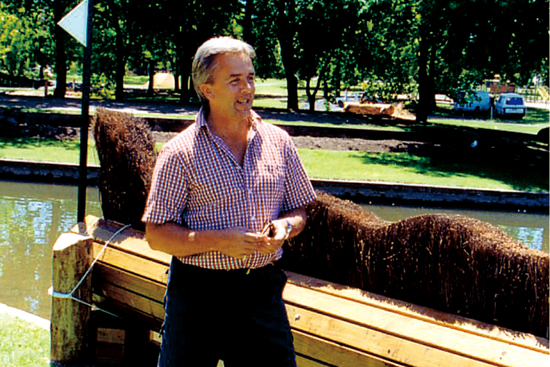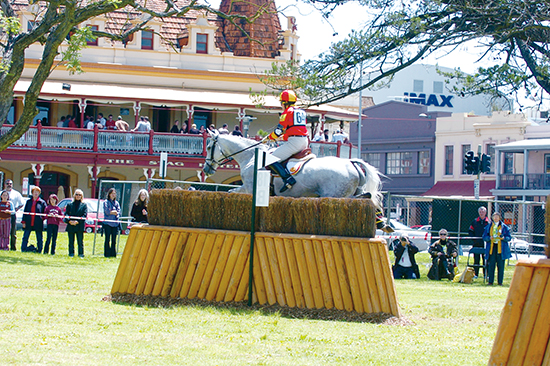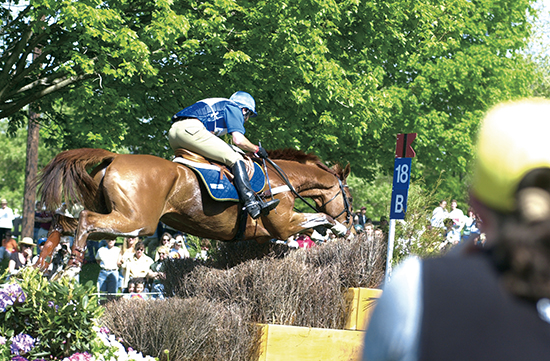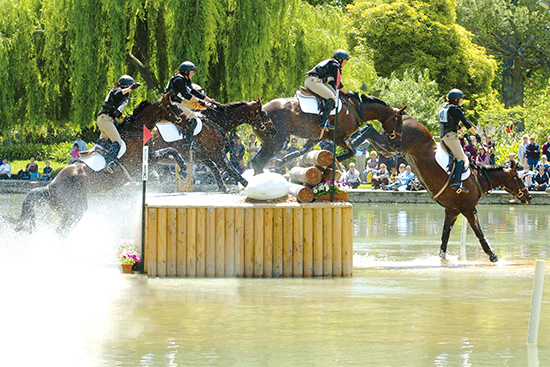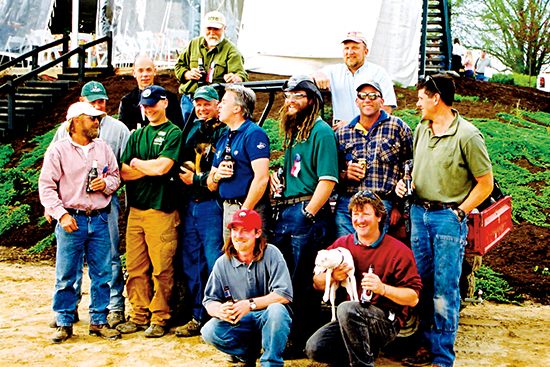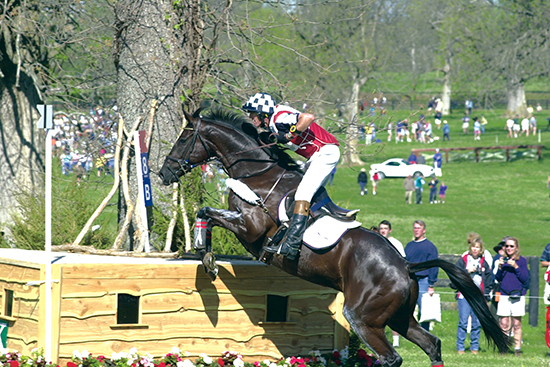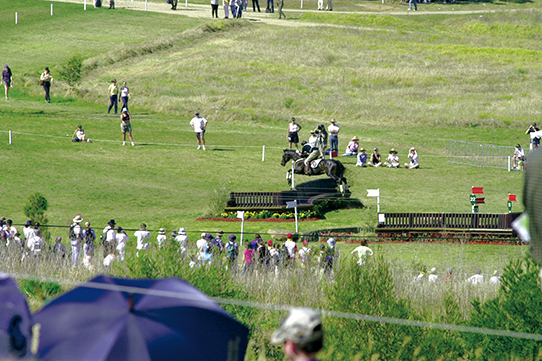 Story by Kellie McIntyre and photos by Kellie McIntyre and Roz Neave
Story by Kellie McIntyre and photos by Kellie McIntyre and Roz Neave
Ever ride a course and wonder ‘what on earth was the designer thinking?’
Well, wonder no more. International Cross Country course designer Mike Etherington-Smith takes us out on course and into his mind.
“If people aren’t up to answering questions, they shouldn’t be punished for it. But if they don’t use their brain, they deserve to screw up.”
So says Mike Etherington-Smith. Designer for two of the world’s four CCI**** events (Rolex and our very own Mitsubishi Adelaide International Horse Trials). The man behind the Sydney Olympics, Blenheim and too many cross-country courses in the UK and US to list here. Designer for the 2007 Pan Ams in Brazil.
“He is, I believe, the greatest designer in the world,” says Jane Atkinson, organizer and original instigator of the Rolex Kentucky CCI**** event. “And what makes him so great is the way he sees the course, the way thinks about it and the way he looks at it.”
Etherington-Smith, as with every course designer in the world, looks first at the terrain. The fields, hills, lakes and gullies that offer natural obstacles on the proposed track. He meets with the organisers. Gets a handle on how they see the event unfolding, and how they hope it will evolve in the next five years.
“It’s a question of using the land to the best of its ability,” says Etherington-Smith. “The sites do determine things a little bit – Adelaide is quite intimate. It’s not as big and open as Kentucky.”
“I’ve seen him stand there with his hands on imaginary reins and ride (the horse) to the fence,” says Jane Atkinson. “He can see it, he can look at it and he will move things a quarter of an inch, but that quarter of an inch obviously makes a major difference because these are the most horse-friendly courses.”
Etherington-Smith recommends that riders follow his lead – start by walking the course alone, free from distractions. Try and see it as your horse will.
“The most important course walk is the first one. What you are looking at on that first walk is what the horses will be seeing.”
Courses are designed for the most efficient use of available space. That means taking into account how riders will approach from the stables and where spectators will flow from the car parks. Finding the best vantage points for TV cameras to capture the action.
As he walks the course, a picture is being formed in the designer’s mind. Which jumps will go where. Where to start and finish so that questions are asked of horses and riders in a logical order.
“The designer is intending to produce an overall package that asks a variety of questions to find out if the rider can ride”, Etherington-Smith explains. “A course shouldn’t be just a series of jumps. There should be a reason for every jump. It has to have a flow, a rhythm to it. It is much like a story – it must have a beginning, a middle and an ending.”
The beginning is the warm-up phase, while “the guts of the course is where you really start to ask the questions.”
Over time, the style of those jumps in the ‘guts’ has evolved with the skills of the riders. Questions that would have been a challenge in years gone by are now considered basic.
“30 years ago, you could separate the riders out with big run-and-jump fences,” says Etherington-Smith. “Nowadays, any horse at any level should be able to jump a jump at maximum dimensions. Those straight-forward fences are stocking fillers.”
They also serve as handy warm-up devices, so expect to find (as at Adelaide this year) big ‘power’ jumps at jump one, two and three. The designer is giving the horse an opportunity to find its stride and build confidence before the real challenges start.
Stag Corner, a set of maximum height brush apexes that required the horses to jump on a bending line, testing the riders’ ability.
At jump 4, it all really begins. The first technical questions are being posed. From here on in, focus is paramount. As you walk the course consider not just the jump, but where it lies in the grand scheme of things. What has come before it? How is the horse feeling by this stage – elated, excited and moving fast after a straightforward fence? Hesitant after a tricky technical combination? Weary as you approach the latter stages?
You can bet the course designer has taken all of this into account, and plotted the next jump accordingly. He will want to see whether your skills, communication and personal confidence can coax the horse into a different pace and frame of mind.
“When there’s an event going, I watch how the horses cover the ground,” says Etherington-Smith. “See what they can and cannot do, and what is a reasonable question for a rider at that level. We are testing for control, pace, use of ground…there’s no one issue, it’s a mix of half a dozen issues. It boils down to how you use the ground, how you put the package together.”
This year’s Adelaide course contained several prime examples of the, ‘next jump, different question’ design technique – most spectacularly at the lake. Horses headed into the water via the ‘RM Williams Bounce’ – a test of ‘athleticism and confidence’. What came next was the undoing of many an experienced combination – a new bank in the water called ‘The Leap of Faith’. Horses had to leap up on to the bank, then jump over stacked rails and down into the water on the other side. A feat requiring serious control and slow speed…. just seconds after the ‘forward momentum’ RM Williams Bounce.
The very next jump was ‘Stag Corner’, a set of maximum height brush apexes that required the horses to jump on a bending line, testing the riders’ ability to steer the horses away from an obvious run-out opportunity. It was the second apex combination the riders had faced that day.
“There should be a key to every course at the higher levels,” explains Etherington-Smith. “There is a relationship between all the fences – if you can sow an element of doubt early on, then they will be wondering if they can jump a similar type of fence later in the course.”
So much of successful cross-country course riding is about the communication between horse and rider. With that communication comes responsibility. Approaching each jump, it is all about confidence – the confidence to know how that particular question should be answered, and the confidence to convey that to your horse.
That trust and communication is something that is built as you ascend through the various levels. The temptation to race at top speed around what appears to be a ‘simple’ course at the lower levels of competition may be great. But by doing so you miss opportunities to teach your horse important technical lessons that will be crucial in the bigger, faster, higher courses to come.
“One of the most difficult things we have in the lower levels is trying to control speed in a fair way,” says Etherington-Smith. “The most important thing for people just coming up to a new level is to give the horse a chance to learn and develop, not just run around willy-nilly.”
One of the most difficult things we have in the lower levels is trying to control speed in a fair way.
And at the end of the day, Etherington-Smith believes this is the core responsibility of a course designer. To develop horse and rider combinations. A responsibility that dictates designers walk a fine line.
“I am looking to produce a competition that educates, asks questions and builds confidence,” he explains. “Some people are stepping up to that level for the first time. They have to have the confidence that they can do it after walking the course. It’s about looking after the bottom end, while still providing a challenge for those who should already be confident at that level.”
The mark of a great designer is in his courses. The way horses and riders feel approaching them, riding them and completing them. Etherington-Smith says that while all designers follow the same set of principles, each designer adds his own nuances.
The fence building crew at Rolex in Kentucky – and they reckon the fences are scary!
Jane Atkinson echoes the opinions of many in the equestrian community when she asserts that Mike Etherington-Smith’s are the best examples of course design you will find.
“You can watch a horse that has never done a four star before start on Mike’s course. They go around, and by the time they are finished, they are a four star horse. They may have had a stop along the way, or a runout, but that doesn’t beat them down. And by the time they’ve done the course, they’re ready to tackle any four star course in the world.”
Ever ride a course and wonder ‘what on earth was the designer thinking?’
First published in THM April 2005.




